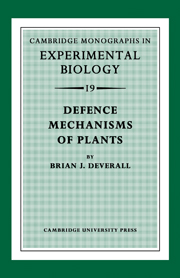Book contents
- Frontmatter
- Contents
- Preface
- 1 INTRODUCTION TO THE HOST–PARASITE INTERACTION
- 2 DISCRIMINATORY EVENTS BEFORE AND DURING PENETRATION INTO PLANTS
- 3 CYTOLOGICAL CHANGES IN HOST AND PARASITE AFTER INFECTION
- 4 CROSS-PROTECTION AND INDUCED RESISTANCE
- 5 PHYTOALEXINS AND THEIR INDUCED FORMATION AND BIOSYNTHESIS
- 6 ROLE OF PHYTOALEXINS IN DEFENCE MECHANISMS
- 7 MEDIATION OF HOST–PARASITE SPECIFICITY
- References
- Index
1 - INTRODUCTION TO THE HOST–PARASITE INTERACTION
Published online by Cambridge University Press: 10 May 2010
- Frontmatter
- Contents
- Preface
- 1 INTRODUCTION TO THE HOST–PARASITE INTERACTION
- 2 DISCRIMINATORY EVENTS BEFORE AND DURING PENETRATION INTO PLANTS
- 3 CYTOLOGICAL CHANGES IN HOST AND PARASITE AFTER INFECTION
- 4 CROSS-PROTECTION AND INDUCED RESISTANCE
- 5 PHYTOALEXINS AND THEIR INDUCED FORMATION AND BIOSYNTHESIS
- 6 ROLE OF PHYTOALEXINS IN DEFENCE MECHANISMS
- 7 MEDIATION OF HOST–PARASITE SPECIFICITY
- References
- Index
Summary
Plants at all stages of their life-cycles are exposed to many potentially parasitic micro-organisms. Seeds germinate in soils which contain numerous resting parasites awaiting the arrival of roots to stimulate them into activity. Aerial parts of plants are inoculated by fungal spores and bacterial cells carried in air currents and rain-splash droplets. Under favourable conditions of moisture and temperature, plant tissues are thus subjected to attempted infection on numerous occasions. However, these attempts often fail, and most plants remain healthy. Successful establishment of a parasite depends upon a special genetical and physiological relationship so that the cells of the host accept the parasite.
This book is concerned with the processes whereby plants succeed in remaining healthy despite their constant exposure to potential parasites. It leads to a consideration of one of the most interesting problems in biology and biochemistry, namely the molecular basis of the high degree of specialization which is often observed in relationships between parasites and hosts. As will become apparent, there are reasons to believe that the basis of much specialized parasitism rests in the ability of parasites to confound a recognition system linked to other reactions in host cells. Through this linked system, the host normally notices and then fails to accept the intrusion of an alien organism.
- Type
- Chapter
- Information
- Defence Mechanisms of Plants , pp. 1 - 6Publisher: Cambridge University PressPrint publication year: 1977



